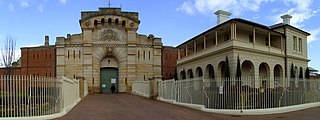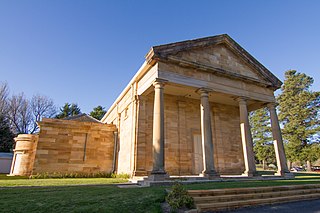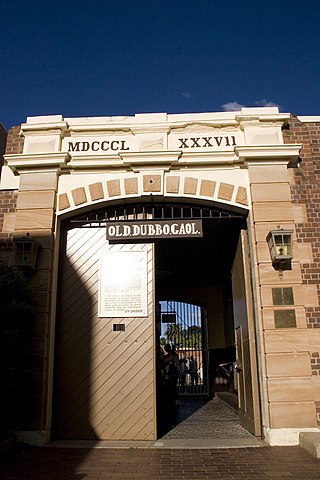
Risdon Prison Complex is an Australian medium to maximum security prison for males located in Risdon Vale near Hobart, Tasmania. The facility is operated by the Tasmanian Prison Service, an agency of the Department of Justice of the Government of Tasmania. The facility accepts criminals convicted under Tasmanian and/or Commonwealth legislation.

The Long Bay Correctional Complex, commonly called Long Bay, is a correctional facility comprising a heritage-listed maximum and minimum security prison for males and females and a hospital to treat prisoners, psychiatric cases and remandees, located in Malabar, Sydney, New South Wales, Australia. The complex is located approximately 14 kilometres (8.7 mi) south of the Sydney CBD and is contained within a 32-hectare (79-acre) site. The facility is operated by Corrective Services New South Wales, a department administered by the Government of New South Wales.
Broken Hill Correctional Centre, formerly Broken Hill Gaol, is an Australian minimum and medium security prison for men and women located in Broken Hill, New South Wales, around 1,190 km (740 mi) from Sydney. Opened in 1892, it is the fourth-oldest prison still in operation in NSW.
Parklea Correctional Centre, a privately managed Australian maximum and minimum security prison for males, is located at Parklea, in the north-western suburbs of Sydney, New South Wales. The facility is operated by MTC Ventia and has a current capacity for 1,350 inmates. The Centre accepts prisoners charged and convicted under New South Wales and/or Commonwealth legislation and incorporates a minimum-security work-release centre for inmates nearing release with a capacity of 120. A Compulsory Drug Treatment Correctional unit is incorporated within the centre.

The Goulburn Correctional Centre, is an Australian supermaximum security prison for males. It is located in Goulburn, New South Wales, three kilometres north-east of the central business district. The facility is operated by Corrective Services NSW. The Complex accepts prisoners charged and convicted under New South Wales and/or Commonwealth legislation and serves as a reception prison for Southern New South Wales, and, in some cases, for inmates from the Australian Capital Territory.
Lithgow Correctional Centre is a prison near Lithgow, Australia, operated by Corrective Services NSW, an agency of the New South Wales state government. The prison houses sentenced male inmates with a maximum security classification.

The Silverwater Correctional Complex, an Australian maximum and minimum security prison complex for males and females, is located in Silverwater, 21 km (13 mi) west of the Sydney central business district in New South Wales, Australia. The complex is operated by Corrective Services NSW, an agency of the New South Wales Government Department of Communities and Justice.

The Parramatta Correctional Centre is a heritage-listed former medium security prison for males on the corner of O'Connell and Dunlop Streets, North Parramatta, Sydney, New South Wales, Australia. It was in operation between 1798 and 2011. The centre was initially called Parramatta Gaol until its name was changed to Parramatta Correctional Centre in 1992. When in operation, the centre was managed by Corrective Services NSW, an agency of the Department of Communities and Justice of the Government of New South Wales. Immediately prior to its closure, the centre detained short term sentenced and remand inmates, operated as a transient centre, and was the periodic detention centre for metropolitan Sydney.

Bathurst Correctional Centre, originally built as Bathurst Gaol in 1888, is a prison for men and women located in the city of Bathurst, New South Wales, Australia, and operated by the Department of Communities and Justice. Bathurst holds inmates sentenced under State or Australian criminal law, along with a small number of remand prisoners.

Cooma Correctional Centre, an Australian minimum to medium prison for males, is located in Cooma, New South Wales. The centre is operated by Corrective Services NSW an agency of the Department of Communities and Justice of the Government of New South Wales. The centre detains sentenced prisoners and persons on remand under New South Wales and/or Commonwealth legislation.

The Old Maitland Gaol, also known as Maitland Correctional Centre, is a heritage-listed former Australian prison located in East Maitland, New South Wales. Its construction was started in 1844 and prisoners first entered the gaol in 1848. By the time of its closure, on 31 January 1998, it had become the longest continuously-run gaol in Australia. It has since been turned into a museum and is a popular tourist attraction. It was added to the New South Wales State Heritage Register on 2 April 1999.

The Berrima Correctional Centre was an Australian prison, located at Berrima, New South Wales. The Centre was operational between 1839 and 2011 with a number of breaks in between, was re-opened in September 2016 and then permanently closed in 2020. Initially established as Berrima Gaol, the facility closed in 1909 and reopened in 1949 as the Berrima Training Centre. The Centre was the oldest Australian correctional facility in operation. It was added to the New South Wales State Heritage Register on 2 April 1999.

Berrima is a historic village in the Southern Highlands of New South Wales, Australia, in Wingecarribee Shire. The village, once a major town, is located on the Old Hume Highway between Sydney and Canberra. It was previously known officially as the Town of Berrima. It is close to the three major towns of the Southern Highlands: Mittagong, Bowral and Moss Vale.

Trial Bay Gaol is a heritage-listed former public works prison and internment camp at Cardwell Street, Arakoon, Kempsey Shire, New South Wales, Australia. The property is owned by the NSW National Parks and Wildlife Service. It was added to the New South Wales State Heritage Register on 14 May 2010.

The Hay Gaol is a heritage-listed former prison and now museum at 355 Church Street, Hay, Hay Shire, New South Wales, Australia. It was an adult prison from 1880 to 1915 and 1930 until 1940, a prisoner-of-war camp during World War II, and a juvenile facility, the Hay Institution for Girls, from 1961 to 1974. It was designed by James Barnet and Colonial Architect and built from 1879 to 1880 by Witcombe Brothers. The site faces Church Street, and is otherwise bounded by Piper, Macauley and Coke Streets, north-east of the town centre. It was added to the New South Wales State Heritage Register on 13 March 2009.
Corrective Services New South Wales (CSNSW) is a division of the Department of Communities and Justice of the Government of New South Wales, Australia. CSNSW is responsible for the state's prisons and a range of programs for managing offenders in the community. The state has 36 prisons, 33 run by CSNSW and three privately operated. The agency traces its origins back to 1788, when New South Wales was founded as a penal colony.

The Old Dubbo Gaol is a heritage-listed former gaol and now museum and tourist attraction at 90 Macquarie Street, Dubbo in the Dubbo Regional Council local government area of New South Wales, Australia. The gaol was designed by the NSW Colonial Architect's Office and was built from 1847 to 1945 by James Atkinson Jnr (1862–63) and William Bonython Moffatt. The gaol is also known as the Dubbo Jail and the Dubbo Gaol. The building was added to the New South Wales State Heritage Register on 26 March 2004. The building was the second gaol in Dubbo, replacing lockups built in 1847 and 1862.
The Bathurst riots were a series of violent incidents that occurred at Bathurst Gaol, a prison in Bathurst, New South Wales, Australia, in October 1970 and February 1974. On both occasions, a sit-in protest by inmates escalated into a prison riot. Each riot was followed by violent reprisals from prison officers, the so-called Bathurst Batterings. The second outbreak of violence at Bathurst led to the partial destruction and temporary closure of the prison, and ultimately to a Royal Commission into the entire State prison system.
The Royal Commission into New South Wales Prisons, also known as the Nagle Royal Commission, was established in 1976 to inquire into the management of prisons in the State of New South Wales, Australia. The commission was headed by Supreme Court Justice John Flood Nagle. Nagle's report, handed down in 1978, described "an inefficient Department administering antiquated and disgraceful gaols; untrained and sometimes ignorant prison officers, resentful, intransigent and incapable of performing their tasks." The first of the Royal Commission's 252 recommendations was the dismissal of Corrective Services Commissioner Walter McGeechan – though the Government sacked McGeechan three months before receiving Nagle's final report.















